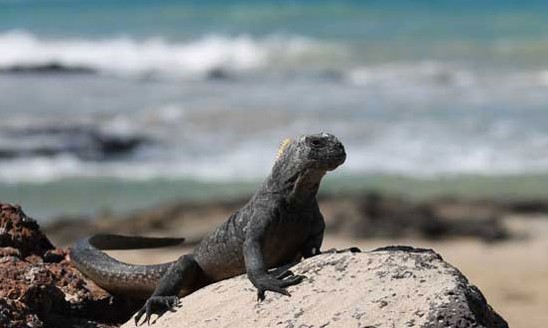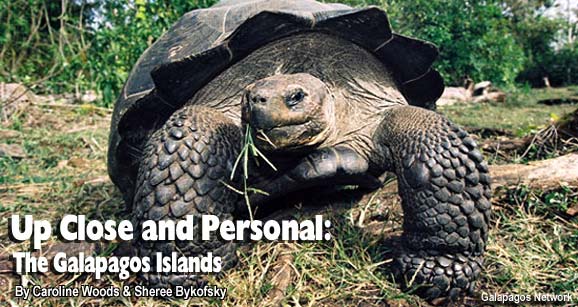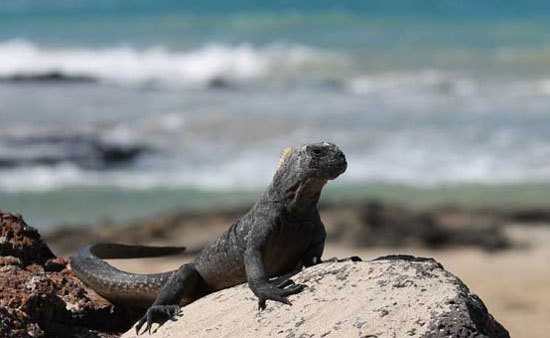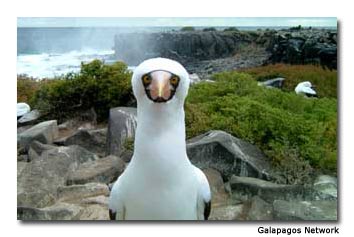
 The Galápagos rocks! Literally. As you trek over lava rocks, you might be lucky enough to see a volcano erupting from one of the 13 larger islands and many islets that form the dazzling archipelago. The last eruption was in October 2005.
The Galápagos rocks! Literally. As you trek over lava rocks, you might be lucky enough to see a volcano erupting from one of the 13 larger islands and many islets that form the dazzling archipelago. The last eruption was in October 2005.
Roughly 620 miles (1,000 km) off the coast of South America in the Pacific Ocean, and owned by Ecuador, the Galápagos are famous for their vast number of rare species, including unusual birds, unique land and sea iguanas, and the gigantic tortoise for which they are named for. Penguins, owls, whales and dolphins: they’re all here in the stunning islands of the Galápagos.
The area is a paradise for outdoor adventurers, animal enthusiasts, bird watchers, swimmers, snorkelers, hikers and nature lovers who visit the islands by cruise ship. Start your exciting soft-adventure trip with a flight to the seaport city of Guayaquil in Ecuador, the country’s largest metropolis, and its industrial center.
Guayaquil International Airport offers nonstop service to the Galápagos Islands, as well as to many U.S. and European cities. Stay overnight and take a morning flight to Isla San Cristóbal, the fifth largest island of the Galápagos, and home to the provincial capital Puerto Baquerizo Moreno. San Cristobál is where your tour begins.
For people with good sea legs who like to travel in small groups, the 20-passenger fleet of small motor yachts by tour operator Ecoventura is an excellent choice.
Ecoventura offers an intimate cruise experience halfway between luxury and roughing it. Each cabin has a hot shower facility, a moderately comfortable bed or bunk and air conditioning.
The “dolphin deck” provides the most space during your cruise experience, while the lower decks are more snug. Onboard naturalists (two per yacht) are very knowledgeable, and eager to explain every detail of topography, geology and zoology.
The islands are surprisingly far apart, and require overnight journeys. Ships can be rocky, so choose a larger ship if you are prone to being seasick.
The Galápagos Islands were made famous when Charles Darwin visited in 1835 to study the rich variety of wildlife, which contributed to his theory of natural selection. Coming face to face with hundred-year-old tortoises is a humbling and awe-inspiring experience, but that is just the beginning.
 You’ll be thrilled to watch blue-footed boobies soar elegantly into the air and then torpedo dive in groups into the ocean. You can also see a flightless cormorant, which exists nowhere else in the world, spreading its wings to dry.
You’ll be thrilled to watch blue-footed boobies soar elegantly into the air and then torpedo dive in groups into the ocean. You can also see a flightless cormorant, which exists nowhere else in the world, spreading its wings to dry.
Among the sights to see are the red-billed tropicbird playing hit and miss along a cliff; the flirty, funny courtship dance of the waved albatross; and male frigate birds inflating their enormous bright-red pouches to attract mates. The Galápagos are a bird-lover’s dream, because the birds here show no fear.
When Spaniard Tomás de Berlanga discovered the remote archipelago in 1535, he noted the extraordinary tameness of the animals, which continues to fascinate modern visitors. You can walk right up to them and observe their most intimate behaviors.
The islands are located on the equator, yet the climate is modified by the cool Humboldt Current. It can get hot in the afternoon, but is mostly dry and temperate. Rarely does it rain, and the evening brings with them a pleasant, cool breeze.
Every island presents a unique pleasure, the chance to examine up close a different exotic species. Look into the soft eyes of a baby sea lion. Share a private moment with a red-footed booby as she regurgitates squid to nourish her insistent infant.
Find a spectacular view from a bluff. Or trek across the moonscapes created by lava formations. The Technicolor palette of the Galápagos includes red sand, white sand, cobalt blue water, colorful birds and spectacular fish at every turn.
The islands are the perfect escape from the bustle of city life. No eating or gum chewing are allowed here, and you won’t find any litter.

In the past, many plants and animals were introduced to the islands, mainly by pirates and buccaneers. These non-native intruders lack natural predators, and continue to threaten the balance of a fragile ecosystem.
The endangered giant Galápagos tortoise, for example, which weighs up to 500 pounds (227 kg), was hunted nearly to extinction by whalers, fishermen and others for its meat, and its numbers have been further imperiled by dogs, cats and other introduced species.
In 1959, a century after Charles Darwin had published Origin of Species, almost all of the Galápagos, except areas already colonized (today’s population is about 20,000), was declared a national park. The surrounding waters have been classified as the Galápagos Marine Reserve.
Tourism is now strictly regulated to protect the endangered species found here that are unknown outside the archipelago. Well-respected, well-preserved and well-marked, the Galápagos are an almost magical place, where tourists are mindful of nature’s beauty. Do your soul a favor and escape to the Galápagos, where harmony rules.
If You Go
Ecuador Ministry of Tourism: www.vivecuador.com
Ecuador Travel Guide: www.ecuador.com
Galapagos Discovery Tour with Pacific Holidays
- Life of a Champion: Exploring the Muhammad Ali Center in Louisville - April 19, 2024
- What It’s Like to Live as an Expat: Lake Chapala, Mexico - April 18, 2024
- Top 5 Spots for Stargazing in North Carolina - April 17, 2024
